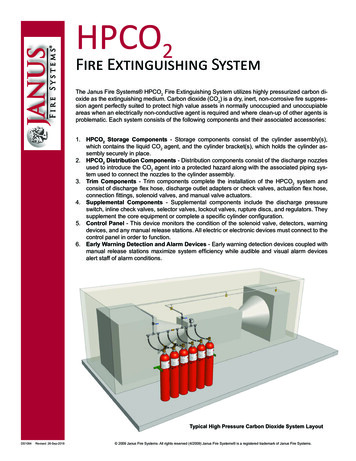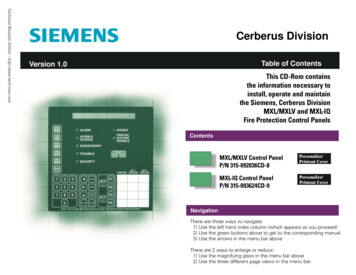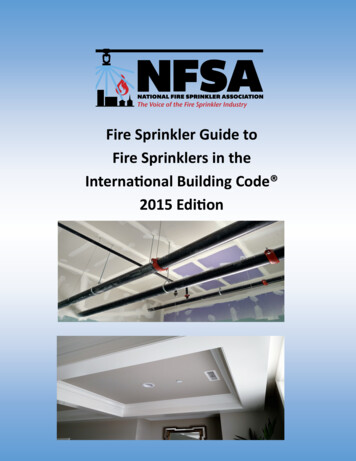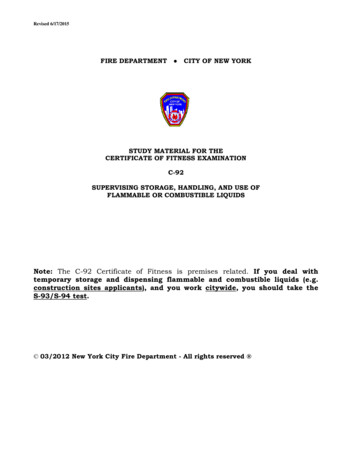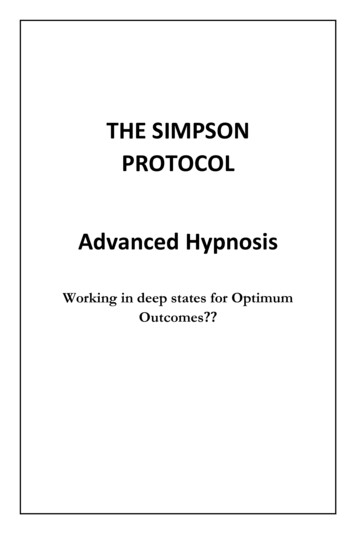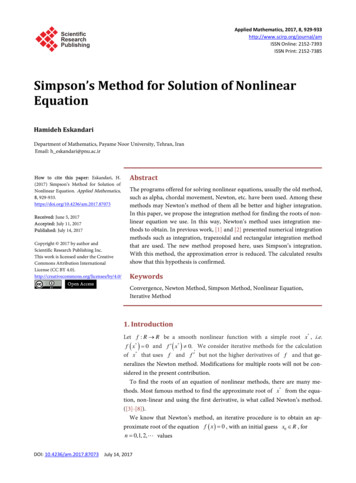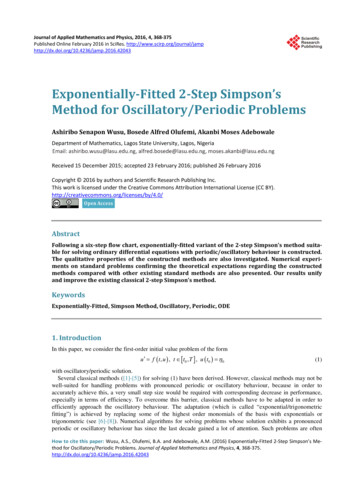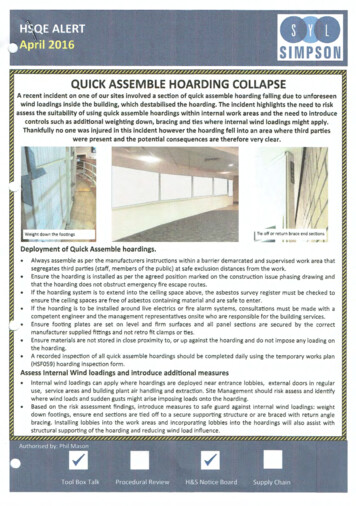
Transcription
SIMPSONQUICK ASSEMBLE HOARDING COLLAPSEA recent incident on one of our sites involved a section of quick assemble hoarding falling due to unforeseenwind loadings inside the building, which destabilised the hoarding. The incident highlights the need to riskassess the suitability of using quick assemble hoardings within internal work areas and the need to introducecontrols such as additional weighting down, bracing and ties where internal wind loadings might apply.Thankfully no one was injured in this incident however the hoarding fell into an area where third partieswere present and the potential consequences are therefore very clear .l.-.2 ,Tie off or ret urn brace end sectionsIlDeployment of Qukk Assemble hoardings. Always assemble as per the manufacturers instructions within a barrier demarcated and supervised work area thatsegregates third parties (staff, members of the public) at safe exclusion distances from the work.Ensure the hoarding is installed as per the agreed position marked on the construction issue phasing drawing andthat the hoarding does not obstruct emergency fire escape routes.If the hoarding system is to extend into the ceiling space above, the asbestos survey register must be checked toensure the ceiling spaces are free of asbestos containing material and are safe to enter.If the hoarding is to be installed around live electrics or fire alarm systems, consultations must be made with acompetent engineer and the management representatives onsite who are responsible for the building services.Ensure footing plates are set on level and firm surfaces and all panel sections are secured by the correctmanufacturer supplied fittings and not retro fit clamps or ties .Ensure materials are not stored in close proximity to, or up against the hoarding and do not impose any loading onthe hoarding.A recorded inspection of all quick assemble hoardings should be completed daily using the temporary works plan(HSF059) hoarding inspection form.Assess Internal Wind loadings and introduce additional measures Internal wind loadings can apply where hoardings are deployed near entrance lobbies, external doors in regularuse, service areas and building plant air handling and extraction . Site Management should risk assess and identifywhere wind loads and sudden gusts might arise imposing loads onto the hoarding.Based on the risk assessment findings, introduce measures to safe guard against internal wind loadings: weightdown footings, ensure end sections are tied off to a secure supporting structure or are braced with return anglebracing. Installing lobbies into the work areas and incorporating lobbies into the hoardings will also assist withstructural supporting of the hoarding and reducing wind load influence 11-,·.Autho.rised by: Phil Mason IITool Box Talk Procedural ReviewIIH&S Notice Board Supply Chain
SIMPSON///////////////////////////////////SPECIFIC REQUIREMENTS FOR SUBCONTRACTORS 01\4 SIMPSON SITESBEFORE ALLOCATING WORK TO SUBCONTRACTORSIn addition to the contractual agreements with subcontractors, the following requirements should be metprior to subcontracting companies being allocated work on a SIMPSON site: All subcontractors should have registered with Constructionline and be able to provideproof of registration. Their operatives should hold valid CSCS cards for the job role being conducted on site. All operatives attending site should have certificated proof of attending and achieving apass rate on a UKATA or ITAP Asbestos awareness course.r J, 1·*construction 1nePRIOR TO ARRIVING ON SITEThe following documentation should be forwarded by the subcontracting teamto the Contracts Manager for review and approval:1. Risk Assessments pertinent to the tasks being conducted on site2. Method statements detailing the process for the tasks3. COSHH assessments with Material Data sheets for the hazardous materi als they propose to use on siteCO STRt;CTIQN SKILLSCERTIFICATIO'i SCHEMEON ARRIVAL AT SITEThe following documentation should be brought to site with the subcontractors attending for induction: CSCS CARD, ASBESTOS AWARENESS CERTIFICATE, RELEVANT QUALIFICATION CARDS /CERTIFICATESiV.PAPER COPIES OF:a. Risk Assessments pertinent to the tasks being conducted on siteb. Method statements detailing the process for the tasksc. COSHH assessments with Material Data sheets for the hazardous materials they propose to use onsite.itThe paper copies MUST be signed at induction by the relevant subcontractor attending site to state theyhave read and understood the information.- - .-"-I,.,. . .- II.,.The subcontracting company should provide a supervisor to oversee their activities on site.Along with their general supervisory duties, the subcontractor supervisor will be responsible for:a. Conducting and documenting regular site inspections for the progress of the job and the H&S issuesassociated with their work activity and providing a copy of the information to the SIMPSON site management teamb. Conducting weekly toolbox talks to their teams and provide a register of attendees to the SIMPSONsite teamc. 'Clean as you go' housekeeping regime on all SIMPSON sites- clearing and removing debris in atimely manner.
SIMPSONTOOL BOX TALK HOT WORKS!Process fire risksWhat you need to doThe Regulatory Reform (Fire Safety) Order 2005 sets out !.!1t:1 laYL t9 on construction site general firesafety, including means of escape.The COM Regulations 2015:i:;:ialso impose duties including the requirement to prevent risk from fire. Thefire risk from site activities must be assessed and precautions taken to control: Combustible material - the quantity of combustible materials on site should be kept to the minimum andall such materials safely stored and used. Ignition sources - action is needed to eliminate, reduce and control ignition sources on site.Construction of timber frame buildings will require significant additional measures to those outlined here.You should refer to the specific guidance listed in Resources, below.What you need to knowEach year there are a number of serious fires on construction sites and buildings undergoingrefurbishment. Many could be avoided by careful planning and control of work activities.Any outbreak of fire threatens the safety of those on site and will be costly in damage and delay. It can alsobe a hazard to people in surrounding properties.
}Fire can be a particular hazard in refurbishment work when there is a lot of dry timber and at the laterstages of building jobs where flammable materials such as adhesives, insulating materials and softfurnishings are presentCombustible materialMany solids, liquids and gases can catch fire and bum. It only takes a source of ignition, which may be asmall flame or an electrical spark, together with air. Preventive actions that can be taken include: Quantity: fire risk can be reduced by controlling the amount of combustible material in the work areauntil it is needed; Flammability: it may be possible to specify materials that are less combustible. Remember that whenworked on, materials may become more easily ignited eg solids turned to dust or crumb; Storage: combustible materials should ideally be stored outside buildings under construction, especiallyvolatile materials eg LPG. Internal storage must be planned and located where it will not put workers atrisk; Rubbish: good housekeeping and site tidiness are important to prevent fire and to ensure thatemergency routes do not become obstructed ; Volatile flammable materials: extra precautions are needed for flammable liquids, gases and oxygencylinders especially when internally stored; Coverings and sheeting: protective coverings and scaffold sheeting may add to fire risk. This can bereduced by use of flame retardant materials; LPG:. liquefied petroleum gas (LPG) is widely used in construction eg in connection with bitumen boilersand site accommodation. LP 3 has been involved in many serious fires and explosions, particularlywhere there have been leaks in confined areas. Strict precautions are required where LPG is stored andused; and Tanks and services: demolition projects can involve an increased risk of fire and explosion.Dismantling of tank structures may cause ignition of flammable residues or disruption and ignition ofburied gas services.Ignition sourcesIt is important that you take action to control ignition sources including:Hot work: all hot work generating heat, sparks or flame can cause a fire. Precautions include: oclearing the area of combustible materials;osuitable fire extinguishers: and
omaintaining a careful watch throughout the work.oa permit to work (PTW) system can help manage the risk on larger projects.Plant and equipment: select electrical and engine driven plant of suitable capacity to preventoverheating. Fasten lamps to a solid backing and, if mounted on tripods, make sure the tripod is stable.Electrical equipment in flammable atmospheres must be suitable for the nature and extent of theflammable atmosphere; Smoking: bring the rules on smoking to the attention of all workers and visitors to the site and enforcethem; Electrical installations: should be of sufficient capacity for the intended use and designed, installed,inspected and maintained by competent people; Bonfires: should not normally be allowed on site. There should be alternative arrangements for theproper disposal of rubbi sh and waste; Arson: measures should be in place to prevent unauthorised site access. Sites with high fire loading ora history of vandalism and arson may need additional measures eg lighting , out-of-hours security orCCTV.
SIMPSONCONSTRUCTION MANAGER RECEIVES A 6 VEAR PRISONSENTENCE FOLLOWING EMPLOYEE'S FATAL FALL FROM HEIGHTThe director of a demolition company has been jailed for gross negligence and manslaughter after two employees fell froma roof on the same day. Mr Scott Harrower sustained fatal head injuries from his fall and his colleague sustained lifechanging injuries.On the 8th April 2016, Mr Alan Thompson of Building and Dismantling Contractors Ltd was jailed for six years, fined 400,000 and was ordered to pay 55,000 court costs for offences committed under Section 2 of the Health and Safety atWork Act and for breaching Regulations 4 and 7 of the Work at Height Regulations. Mr Thompson not only failed to planand provide a safe method of work, but also failed to act on a significant near miss event and a serious accident, both ofwhich occurred prior to the fatal accident.The Principal Contractor for the project, C. Smith and Sons, were also prosecuted and found guilty of safety offences. Theowner, Mr Michael Smith was jailed for eight months, fined 90,000 and ordered to pay 45,000 court costs.Mr Scott Harrower died followinga fall from height through anunguarded skylight during thedemolition work.CPSThe work required dismantling of a steel corrugated sheet roofing with interspersed plastic skylights, which haddeteriorated over time and had subsequently been covered with corrugated steel sheets in a bid to weather proof them.The court heard it was originally planned that machinery would be used to remotely bring down the roof structure, a methodthat would have entailed minimum risk to the workers. However between winning the contract and the work being carriedout, the decision was taken by Mr Smith.that the building should instead be dismantled piece by piece, meaning workmenwould be required to work at height to remove the roof sheets prior to the structure being unbolted.On the 20th January 2014, Mr Harrower accidentally stepped through a skylight and nearly fell the 30 feet to the concretefloor below. However, this significant near miss did not prevent the men from returning to carry out their work the next day.At 9am on Tuesday 21st January 2014, another worker fell through a skylight to the concrete floor below, fracturing his spine,pelvis, right leg, heel and wrist. Despite such an horrific incident, the men were ordered by Mr Thompson to return to workjust hours later. At 4pm that same day Mr Harrower fell through a skylight to the concrete below sustaining fatal headinjuries.The HSE Chief Inspector Richard Eales for the prosecution concluded:"It is clear from the evidence that both Mr Smith and Mr Thomson saw an opportunity to make a quick profit without anythought for the workers they sent on to the roof, and as a direct result of that greed Mr Harrower died and another mansuffered life-changing injuries. Thankfully, the jury saw through their attempts and both now can face justice for the decisionsthat they made, decisions that have robbed one family of a loving partner, father, and son, and another of a man's ability tolive a life untainted by severe physical injury."
SIMPSONLeai"ning OL.tcomes from a serious incident ;nvo.ving falling materialsThe incident, on a SIMPSON site, involved a full roll of flooring material being knocked over as the floor layers weretransporting the rolls onto site. The large roll fell on to an operative who was bent over preparing the floor surfacewith his back to the material storage activity.This incident resulted in the operative sustaining internal injuries requiring hospital t reatment. The injured personhas been off work for a number of weeks and is still undergoing investigative tests at the hospital as an out patient.Following on from this serious incident; the investigation establishedthat the injured party had not attended a site induction or signed offon the appropriate risk assessments and method statements to indicate that he had read and understood the content.The risk assessment and method statement relating to the transporting of materials and storing of materials had not been presented tothe site team.LEARl\ll uS AND ACTIONS TO BE TAKEN1.Site Management MUST ensure ALL individuals attending sitehave been inducted and a copy of the induction record is filed.2.Site Management should also ensure that they receive copies ofRisk Assessments and Method statements for unloading andtransportation of goods onto site; including material storage onsite.3.Materials should be located in an area where they can be easilyaccessed, however this should not be in an area where they willbe knocked over or damaged.4.Ensure all operatives are made aware of other trades work activities and actions that may impact on theirwork, or the area they are working in, by conducting a communication briefing at the start of the work period.5.Ensure all operatives attending night shift are inducted on to site without exception i.e. even if they have attended a day shift induction, the situations and hazards on night /evening shifts may be different to day shifti.e. different fire exits/ alarm evacuation.6.Daily shift briefings on hazardous operations/ storage arrangements should be conducted with the site teamwhen applicable.7.When an accident or incident occurs on site, once the injured party has been dealt with, a member of the HSQEteam MUST be informed as soon as possible. They will be able to assist with the accident investigation if necessary. This also applies to minor accidents.
///.Changes to Hazardous Waste RegulationsWhat are the changes?There are two key changes to the regulations :1.Premises RegistrationUnder current regulations any premises producing 500kg or more of hazardous waste per year must register theirpremises with the Environment Agency . From 1st April 2016 premises in England will no longer need to regist ertheir premises with the Environment Agency. This can be done on the Gov website via the attached link - cost is egistration2.Consignment Note ChangesTo accommodate the removal of premises registration, the format of the consignment note code which appears onevery consignment note, will change from 1st April 2016 . For waste produced in England, the first six characters ofthe consignment note code, which is currently the premises registration number must be replaced by the first sixletters or numbers of the business name. The producer should ensure consistent use of the organisation name.These changes only apply to England, premises in Wales should continue to register with Natural Resources Wales.SIC Codes1he requirement for the SIC code on the consignment note will also change as of 1st April 2016. Currently SIC 2003,SIC 2007 or NACE is accepted on consignment notes. The change in regulations from 1st April 2016 specifies thatSIC 2007 is used on all consignment notes which matches the legal requirements for waste transfer notes (for nonhazardous waste).Other useful links :https ://www.gov.u k/how-to-classify-d iffere nt s-waste
\TOOL BOX TALK: HOUSEKEEPINGSome people think it's a waste of time. But if you spend just a few minutes p icking up,you might keep someone from slipping or tripping. You could prevent an injury thatkeeps them off work for weeks or even months. Five minutes to save months offworkit's a good investment. And next time, it could be you who gets hurt.Housekeeping is everyone's job--every trade, every worker, and every supervisor. Andit's a job you should do every day-not just once a week or when a project is over. Thefirst rule is to do your work neatly in the first place, and clean up after yourself. Goodhousekeeping does more than prevent injuries--it can save you time, and it can keep yourtools from being lost, damaged, or destroyed.What can you do to prevent slips, trips, and falls? If you see a mess, take care of it. Don't wait for someone else to clean it up. Pickup anything you see lying around, especially if it could trip someone or fall.If you find someone's tools or equipment around, move them out of the way. Putthem somewhere safe, but visible.Immediately clear scrap and debris from walkways, passageways, stairs,scaffolds, and around floor openings.Make sure the ground is level and well-graded within six feet of buildings.Keep storage areas and walkways free of holes and obstructions.Clean up spills of grease, oil, or other liquids at once. If it's not possible, coverthem with sand or some other absorbent material until they can be cleaned up.Someone might slip.Coil up extension cords, lines, welding leads, hoses, etc. when not in use.Make sure there's adequate lighting. If a light is out, report it. Replace itimmediately if you can.Watch the weather closely and monitor both interior and exterior walkways.Keep exit paths free from obstruction.Remember, our actions can have a significant impact on others. A clean and orderlyworkplace shows you take pride in your work and makes everyone's work environmentmore pleasant. Environmental Management Consulting, Inc.1-800-279-2020www.emc-wi.com
Y INSPECTION AND TEST PLANA recent fatality in the shop fitting industry highlights the importance of ensuring that on all SIMPSONprojects there is a quality inspection and test plan developed (refer to appendix section of the ConstructionPhase Plan) with quality inspections undertaken and recorded during all key phases of the construction phaseworks i.e. demolition, soft strip, civils, construction, commissioning and testing phases.Michael Kelly, 26yrs and a joiner from Glasgow, was killed when he was struck byfalling signage and a fascia assembly, during shop fitting work at a retail unit.The Health and Safety Executive (HSE) investigation found that the company failedto properly assess the supporting arrangements for the signage and fascia assumingthey were supported by steel hangers and that it would be safe to remove the shopfronts.The employer cohcerned pleaded guilty to breaching Section 2 (1) and Section 3 (1). of the Health and Sa
ensure the ceiling spaces are free of asbestos containing material and are safe to enter. . Tool Box Talk Procedural Review H&S Notice Board Supply Chain . . Conducting weekly toolbox talks to their
